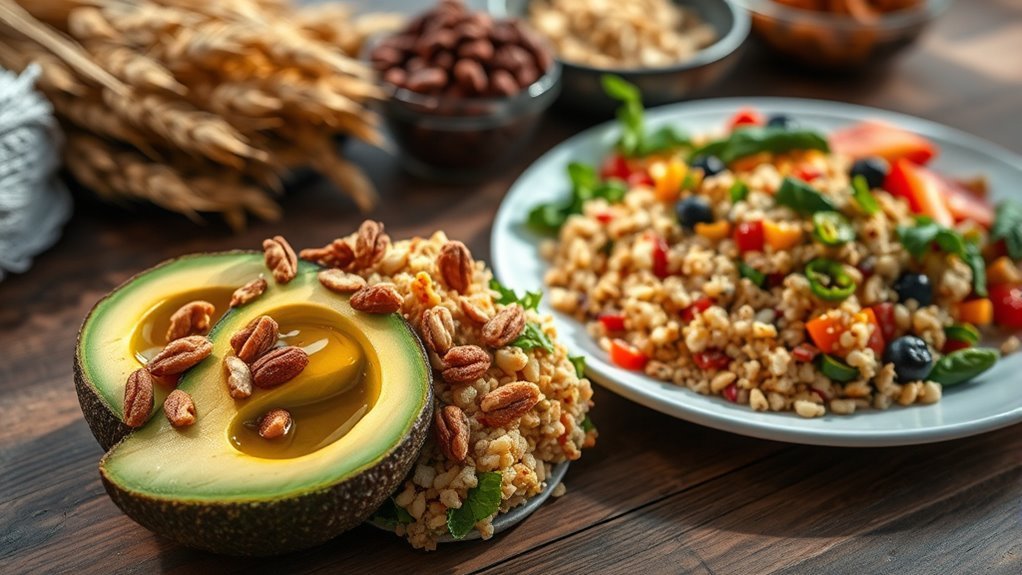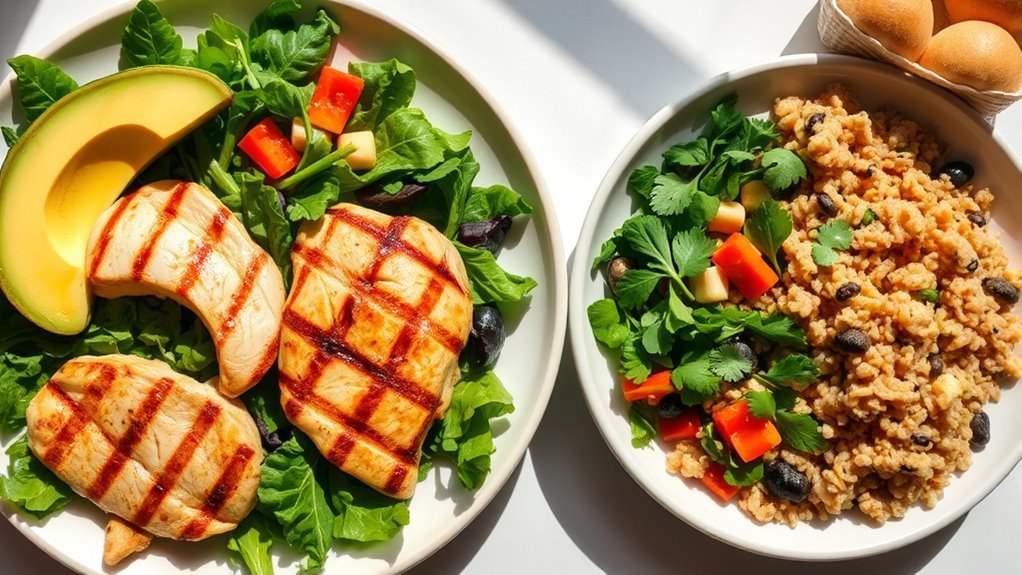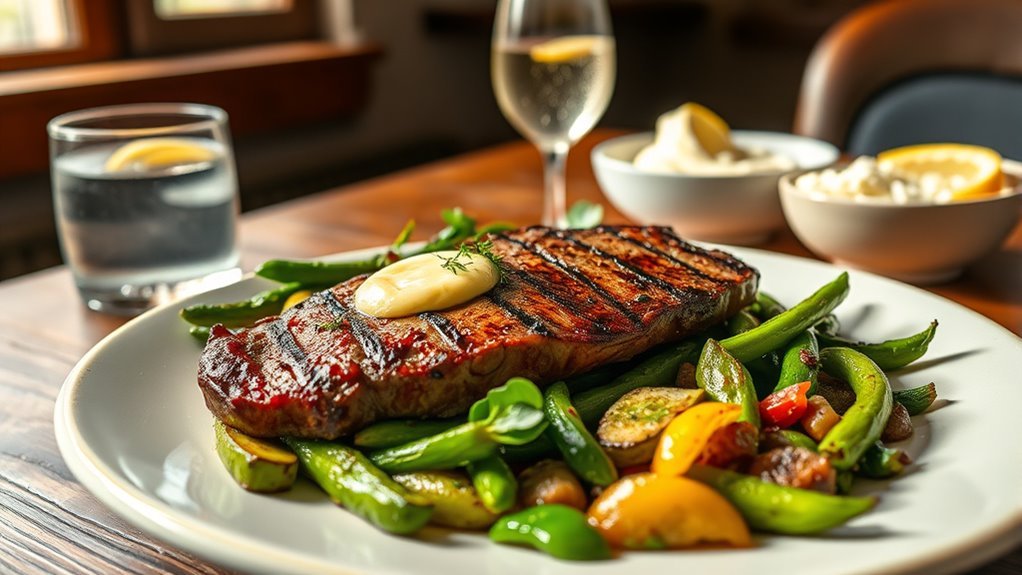Keto and gluten-free aren’t the same. The ketogenic diet focuses on low carbs and high fats to promote fat burning, while a gluten-free diet eliminates gluten to address sensitivities, like celiac disease. Not all keto foods are gluten-free, and many gluten-free options can be high in sugar. Each diet serves different health goals, so it’s important to choose one that fits your needs. If you’re curious about the specifics of each diet, there’s more to explore.
Understanding the Ketogenic Diet

When you consider the ketogenic diet, it’s important to understand its fundamental principles and how it works. The keto diet focuses on high-fat, moderate-protein, and low-carbohydrate intake, which encourages your body to enter a state of ketosis. This process allows your body to burn fat for energy instead of carbs. However, there are many keto misconceptions, such as the belief that all fats are good or that you can eat unlimited amounts. Effective keto meal planning is essential to avoid these pitfalls. By carefully selecting whole foods and tracking your macros, you can achieve your health goals without feeling restricted. Embracing this diet can lead to newfound freedom in managing your weight and energy levels, as long as you stay informed and balanced.
The Basics of a Gluten-Free Diet

While many people associate a gluten-free diet with avoiding bread and pasta, it’s essential to understand that gluten is a protein found in wheat, barley, and rye, which can affect those with celiac disease or gluten sensitivity. A gluten-free diet requires you to identify gluten sources in your food and make informed choices that align with your dietary restrictions.
Here’s a simple table to help you navigate gluten sources:
| Gluten Sources | Gluten-Free Alternatives | Tips |
|---|---|---|
| Wheat | Almond flour | Check labels |
| Barley | Quinoa | Choose certified products |
| Rye | Brown rice | Avoid cross-contamination |
| Processed foods | Fresh fruits & veggies | Cook at home when possible |
| Snacks | Popcorn | Read ingredient lists |
Understanding these basics can empower you to enjoy a gluten-free lifestyle.
Key Differences Between Keto and Gluten-Free

Understanding the distinctions between a gluten-free diet and a ketogenic (keto) diet can help you make informed dietary choices. While a gluten-free diet focuses on eliminating gluten-containing foods, primarily for those with celiac disease or gluten sensitivity, keto emphasizes low carbohydrates and high fats for metabolic benefits. Many keto misconceptions suggest that all low-carb foods are gluten-free, which isn’t always true. Conversely, gluten-free myths often imply that these foods are inherently healthy, overlooking their potential high sugar content. It’s essential to recognize that while both diets aim for specific health outcomes, they serve different purposes and require distinct approaches. Knowing these differences will empower you to navigate your dietary journey more effectively.
Nutritional Benefits of Each Diet
As you explore the nutritional benefits of keto and gluten-free diets, it’s important to recognize how each can support different health goals. The keto diet emphasizes high-fat, low-carb foods, promoting weight management through ketosis, which can enhance fat burning while providing energy. This approach often leads to meals rich in nutrient density, as healthy fats and proteins come from sources like avocados, nuts, and grass-fed meats.
In contrast, a gluten-free diet focuses on eliminating gluten-containing grains, which can improve digestive health for those with sensitivities. It encourages whole foods like fruits, vegetables, and gluten-free grains, contributing to nutrient density and overall well-being. Both diets can be beneficial, but their effectiveness largely depends on your individual health objectives and how you implement them.
Choosing the Right Diet for Your Needs
How do you determine which diet is right for you? It’s vital to take into account your dietary preferences and personal goals. The keto diet focuses on high fat and low carbs, while gluten-free is primarily for those with gluten sensitivity or celiac disease. Evaluating your lifestyle and health needs is fundamental in making an informed choice.
| Diet Type | Key Considerations |
|---|---|
| Keto | High fat, low carbs, weight loss |
| Gluten-Free | Eliminates gluten, digestive health |
| Balanced Diet | Nutrient-rich foods, overall wellness |
| Personal Choice | Adapts to needs, preferences, and goals |
Ultimately, the right diet should align with your unique situation and values, enabling you to thrive.
Frequently Asked Questions
Can You Eat Gluten-Free Grains on a Keto Diet?
You might think you can plunge into gluten-free grains while on a keto diet, but hold on! Most keto grains are low in carbs, while gluten alternatives can pack in more carbs than you’d want. Quinoa, for instance, isn’t a keto-friendly choice due to its higher carb content. Instead, focus on options like almond flour or coconut flour to keep your carb count low while enjoying delicious meals that fit your lifestyle!
Does Gluten-Free Mean Low Carb?
No, gluten-free doesn’t automatically mean low carb. Many gluten-free options, like rice and corn-based products, can be high in carbs. It’s a common misconception that going gluten-free guarantees a low-carb diet. If you’re looking for low-carb alternatives, focus on vegetables, nuts, and seeds. Always check labels and nutrition facts to confirm you’re making choices that align with your dietary goals, allowing you the freedom to enjoy food while managing your carb intake effectively.
Are Keto Snacks Usually Gluten-Free?
Yes, most keto snacks are usually gluten-free. You’ll find a variety of keto snack options that cater to your low-carb lifestyle, including nuts, seeds, cheese, and various meat snacks. These are excellent gluten-free alternatives, allowing you to enjoy tasty treats without compromising your dietary goals. However, always check labels to verify there’s no hidden gluten in pre-packaged items. This way, you can snack freely without worry!
Can You Gain Weight on a Gluten-Free Diet?
Yes, you can gain weight on a gluten-free diet. Many people believe that just avoiding gluten automatically leads to weight loss, but that’s a misconception. Gluten-free products can be high in calories and sugars, leading to gluten-free weight gain if consumed excessively. It’s important to focus on whole, nutrient-dense foods rather than processed gluten-free options. Balance and moderation are key, so pay attention to your overall caloric intake, regardless of gluten content.
Is Gluten-Free Soy Sauce Keto-Friendly?
Gluten-free soy sauce options can definitely fit into your keto lifestyle! When you’re searching for suitable substitutes, look for brands that specifically label their products as gluten-free and low in carbs. Many traditional soy sauces contain gluten, but alternatives like tamari are often gluten-free and keto-friendly. Just keep an eye on the carb count, and you’ll find plenty of delicious, dietary-friendly choices that let you enjoy your meals without compromising your goals.


